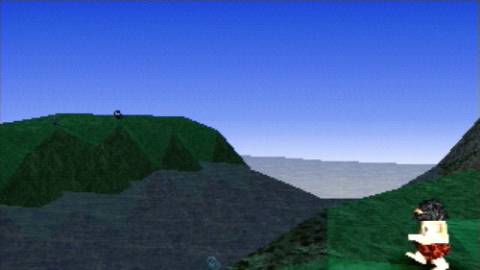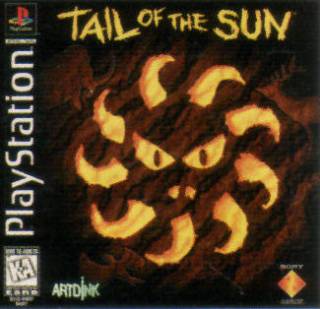Gameplay
Many of the usual game conventions are discarded in Tail of the Sun. For example, rather than having a set number of "lives," you choose a tribe member, of which there are a nearly infinite supply, to play as until his or her death, repeating the process until the end. The world consists of one large landmass consisting of different environments (such as desert, tundra, and grasslands) with no breaks or loading screens. Additionally, the game doesn't present a normal health bar, but rather a ring of flames that slowly burn out, symbolizing the cave person's lifespan. Typically, death occurs due to an attack by wildlife, old age (as denoted by the flames), or drowning, after which you are returned to the tribe to select a new avatar. Your cave person will also get tired from time to time and fall asleep, and will be vulnerable for the duration (usually no more than 1 minute) although this can be manually overridden.
Due to the open-ended nature of the game design, and the difficulty in collecting mammoth tusks, completing the game is seen as something of a challenge. Building the tower to completion can take many hours.
Exploration & Cultural Level Ups
South of the main village are a number of stones which can power up a specific aspect of your tribe including jumping, running, and swimming (for example, the "swimming" stone allows your tribesmen to swim, which is essential for exploring many parts of the expansive game world). You will also acquire cultural level ups from time to time that will improve your tribe's capabilities: lung capacity (for holding your breath); fertility (for making more tribe members); legs (stamina for running); and intelligence (crafting better weapons). For example, though you begin the game with just a stick you will eventually build better weapons, culminating in a spear, which is more effective at taking down large beasts.
The game also keeps track of what animals you kill (in a long scrolling cave painting titled "History" documenting every kill). It appears that killing too many of one type (especially mammoths) leads to a sharp decline in their population numbers, making it difficult to achieve the game's goal. Certain beasts will leave behind meat, which you can choose to eat on the spot or send back to the tribe (the effects of which are unclear but may lead to cultural development).
The game world is very large, especially considering it is contiguous (no load screens) and on the PS1. You will find snow-laden mountains, deserts, jungles, rivers, islands, and caves. Caves can be incredibly deep mazes that often contain hidden treasure troves of mammoth tusks. You will also find a series of strange statues around the world which represent different body parts (including hands, eyes, and a nose) and appear to have been left by an even older civilization.
Graphical and Musical Style
Tail of the Sun uses simple polygonal models and surreal textures to depict the world and its inhabitants. As a result the animals look like simple cave paintings. The world rolls over at the horizon, similar to games like Animal Crossing Wide World (which would be released much later). Weather effects such as rain and snow occur. There is also a progression from day to night, and at night many strange stars and planets stream across the sky with seemingly no rhyme or reason. Scattered around the world are edible plants, flowers, fruits, and nuts, which are actually scanned images of baked goods made by one of the game's staff. Eating these keeps your character in good health, improving certain aspects of the body including lungs, brains, legs and arms. This also may move the cave person closer to a level up, but this is left ambiguous.
Most of the time, the game does not have any background music, preferring instead the ambient sounds of nature. However, from time to time an unexpected burst of techno music begins, only to fade away after a brief time adding to the ambiance of the environment.

 PlayStation
PlayStation.png) PlayStation Network (PS3)
PlayStation Network (PS3).png) PlayStation Network (PSP)
PlayStation Network (PSP)


